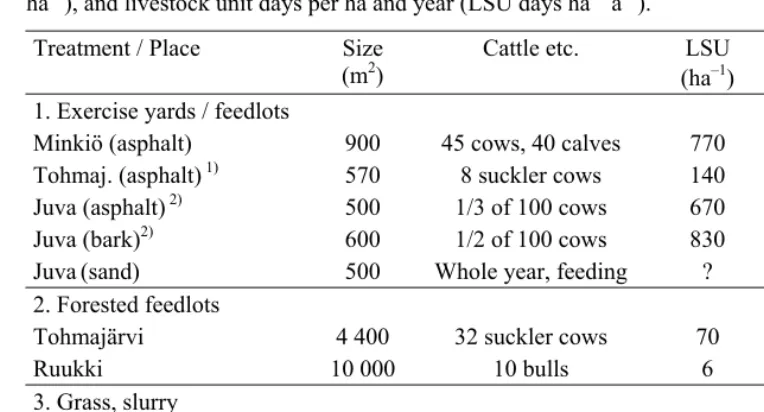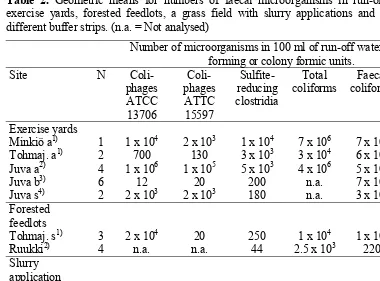NJF Report • Vol. 2 • No 5 • 2006
NJF Seminar 373
Transport and retention of
pollutants from different
production systems.
NJF Report Vol.2 No 5, 2006 NJF Seminar 373
Transport and retention of pollutants from different production systems. Tartu, Estonia, 11–14 June 2006
Editors Toomas Tamm and Liisa Pietola
Liisa Pietola: University of Helsinki, Department of Applied Chemistry and Microbio-logy P.O. Box 27, FIN-00014 Helsinki, FINLAND
Present address: Kemira GrowHow Oyj, Research Centre, P.O. Box 2, FIN-02271 Espoo, FINLAND
Toomas Tamm: Estonian University of Life Scienses, Department of Water Manage-ment. Kreutzwald Str 5, EE51014 Tartu, ESTONIA.
Photo on the cover: Toomas Tamm (view from South-Western Finland)
ISSN No. 1653–2015
Tartu University Press www.tyk.ee
NJF373 Tartu 2006 (101–105)
Faecal microorganisms in run-off
from cattle farming
Jaana Uusi-Kämppä
1, Arto Huuskonen
2, Miia Kuisma
3,
Arja Nykänen
3and Helvi Heinonen-Tanski
41 MTT Agrifood Research Finland, Plant Production Research,
FIN-31600 Jokioinen, Finland, E-mail: jaana.uusi-kamppa@mtt.fi
2 MTT Agrifood Research Finland, Animal Production Research,
Tutkimusasemanie 15, FI-92400 Ruukki, Finland, E-mail: arto.huuskonen@mtt.fi
3 MTT Agrifood Research Finland, Plant Production Research, Huttulantie 1,
FIN-51900 Juva, Finland, E-mails: miia.kuisma@mtt.fi, arja.nykanen@mtt.fi
4 University of Kuopio, Department of Environmental Sciences, PO Box 1627,
FIN-70211 Kuopio, Finland, E-mail:helvi.heinonentanski@uku.fi
Abstract
Numbers of faecal indicator microbes (faecal coliforms, enterococci, sulphite-reducing clostridia and coliphages) were determined in run-off waters from cattle farms in 1998– 2005. Water samples were collected from drain wells and open ditches adjacent to exercise yards and forested feedlots for cattle, a grass field with slurry applications and a pasture with buffer strips. The indicator numbers were the highest in run-off waters from asphalt exercise yards while the figures were even 100-fold smaller in waters from a bark covered yard. In the forested feedlots, where cattle were fed for the winter months or all the year round, the indicator numbers were as high as the ones in a grass field with slurry applications or a pasture. There was a severe risk of transporting patho-gens to the environment, especially if run-off water from exercise yards and feedlots are only poorly purified and allowed to flow into ditches and watercourses. The existence of buffer strips between fields and watercourses may reduce the numbers of faecal microbes in surface run-off.
1. Introduction
J. Uusi-Kämppä, A. Huuskonen, M. Kuisma, A. Nykänen, H. Heinonen-Tanski 102
field drainage (Oliver et al. 2005). Here, observations were made of hygiene
indi-cators in waters in the surroundings of cattle farms.
2. Materials and methods
This paper consist of 6 different studies on hygiene indicator levels in the surroun-dings of Finnish cattle farms. The study sites were located in North Ostrobothnia (Ruukki), South Savo (Juva), North Carelia (Tohmajärvi) and Häme, SW Finland (Jokioinen, Minkiö). Run-off water was sampled from
(1) exercise yards for cattle at Minkiö and Tohmajärvi (Uusi-Kämppä & Heino-nen-Tanski 2000) and Juva (Puumala et al. 2002, Uusi-Kämppä et al. 2003), (2) forested feedlots for cattle at Tohmajärvi (Uusi-Kämppä 2002, Puumala et al.
2002) and Ruukki (Puumal et al. 2002, Uusi-Kämppä et al. 2003),
(3) a grass field with slurry application at Jokioinen (Heinonen-Tanski & Uusi-Kämppä 2001) and
(4) a pasture with different buffer strips at Jokioinen (Uusi-Kämppä & Palojärvi 2006).
Dairy cows exercised for a few hours (4 hours used in calculations in Table 1) daily in the yards at Minkiö and Juva. During four summer months the cows grazed in pastu-res. Run-off samples were collected from wells situated in the exercise yards. Young cattle and suckler cows may sometimes be raised in forested feedlots. At Tohmajärvi, the suckler cows were fed for 7 winter months either in an asphalt feedlot or a forested lot. The cows with calves grazed in a pasture from June to September. At Ruukki, 10 bulls were raised in a forest area (1 ha) all the year round in 2000–2001. At Ruukki, the run-off water was collected from an open ditch adjacent to the feedlot, and at Tohmajärvi, percolation lysimeters installed into soil at a depth of 30–40 cm were used to collect percolation water (Uusi-Kämppä 2002). At Jokioinen, surface run-off samples were collected from a grassed land where cattle slurry was either broadcast or injected into clay soil 1996–2000 (Heinonen-Tanski & Uusi-Kämppä 2001). In the other study at Jokioinen, surface run-off samples were taken from an experimental pasture (Uusi-Kämppä & Palojärvi 2006) with either a 10-m wide grass buffer strip (GBS) or a vegetated buffer strip (VBS). Results from the pasture with GBS and VBS were compared with those from the pasture with a buffer grazed by cattle (gGBS). Two dairy cows and two heifers grazed for 28 days in the pasture (0.7 ha) in summer 2005. Surface and subsurface water to a depth of 30 cm flowed into a collector trench. Water samples were filtered for faecal coliforms and enterococci through Millipore 0.45 um and for sulphite-reducing clostridia through Millipore 0.22 um filters. Faecal
coliforms were then cultivated on mFC agar (DifcoTM) and confirmed by oxidase test
(SFS 4088). Enterococci were cultivated on KF streptococcus agar (Difco), and
colonies were confirmed with 3% H2O2 (SFS 3014). Sulphite-reducing clostridia were
determined by EN 26461-2 (1993) and incubated in an Oxoid anaerobic jar. Water
hygiene was further studied by determining somatic and RNA coliphages (E. coli
Faecal microorganisms in run-off from cattle farming 103
Table 1. The experimental treatments, size of experimental areas, livestock units per ha (LSU ha–1), and livestock unit days per ha and year (LSU days ha–1 a–1).
Treatment / Place Size
(m2) Cattle etc. LSU
(ha–1) LSU day (ha–1 a–1)
1. Exercise yards / feedlots
Minkiö (asphalt) 900 45 cows, 40 calves 770 31 000
Tohmaj. (asphalt) 1) 570 8 suckler cows 140 29 000
Juva (asphalt) 2) 500 1/3 of 100 cows 670 27 000
Juva (bark)2) 600 1/2 of 100 cows 830 50 000
Juva(sand) 500 Whole year, feeding ? ?
2. Forested feedlots
Tohmajärvi 4 400 32 suckler cows 70 15 000
Ruukki 10 000 10 bulls 6 2 200
3. Grass, slurry
Jokioinen 90 tn slurry ha–1 4 1 400
4. Pasture, buffers
Jokioinen 7 200 2 cows, 2 heifers 4 120
1) The asphalt lot with bark covered
2) The yard was divided into two parts: 1/3 of the cows stayed on the asphalt area while 2/3 preferred the
bark surface
1 dairy cow or suckler cow = 1 SLU, 1 heifer or bull (< 2 years) = 0.6 SLU
3. Results and discussion
J. Uusi-Kämppä, A. Huuskonen, M. Kuisma, A. Nykänen, H. Heinonen-Tanski 104
4. Conclusions
[image:6.595.63.443.266.547.2]Although the indicator numbers were less than they are in slurry or in wastewater influent, there was a severe risk of transfer of zoonotic pathogens to the environment, especially when surface run-off water from exercise yards are poorly purified and allowed to flow into ditches and watercourses as recreation waters. In the areas with high animal density there can be also risks that enteric microorganisms spread from one farm to the water are used for irrigation, milk production or other use in the other farm. More research is needed to establish the risk of pathogen transmission from livestock farms in different environments and seasons. Exercise yards and outdoor feedlots should be built so that the risks of pathogen transmission to waters can be controlled.
Table 2. Geometric means for numbers of faecal microorganisms in run-off waters from exercise yards, forested feedlots, a grass field with slurry applications and a pasture with different buffer strips. (n.a. = Not analysed)
Number of microorganisms in 100 ml of run-off water as plaque-forming or colony formic units.
Site N
Coli-phages ATCC 13706 Coli-phages ATTC 15597 Sulfite- reducing clostridia Total
coliforms coliforms Faecal Entero-cocci
Exercise yards
Minkiö a1) 1 1 x 104 2 x 103 1 x 104 7 x 106 7 x 106 3 x 106
Tohmaj. a1) 2 700 130 3 x 103 3 x 104 6 x 103 2 x 104
Juva a2) 4 1 x 106 1 x 105 5 x 103 4 x 106 5 x 106 4 x 106
Juva b3) 6 12 20 200 n.a. 7 x 104 5 x 103
Juva s4) 2 2 x 103 2 x 103 180 n.a. 3 x 105 3 x 104
Forested feedlots
Tohmaj. s1) 3 2 x 104 20 250 1 x 104 1 x 104 4 x 103
Ruukki2) 4 n.a. n.a. 44 2.5 x 103 220 n.a.
Slurry application
Surface5) 3 3 x 103 100 2 x 103 2 x 104 900 5 x 103
Injection5) 3 110 1 69 6 x 103 400 500
Pasture6)
gGBS 8 <0.57 n.a. 2 x 104 9 x 103
GBS 7 <0.57 n.a. 5 x 103 4 x 103
VBS 7 <0.57 n.a. 3 x 104 6 x 103
1) Sampling June 7, 2000, (Uusi-Kämppä & Heinonen-Tanski 2000) 2) a = asphalt area (Apr 2001–Jun 2002), (Uusi-Kämppä et al. 2003)
3) b = bark covered area; sampling from drainage (Jun–Nov 2005), (Kuisma et al. Unpublished). 4) Sand area (Aug–Nov 2005) (Kuisma et al. Unpublished)
5) October 20, 1998; 4 days after slurry application + 38 mm rainfall (Heinonen-Tanski &
Uusi-Kämppä 2001)
6) gGBS = grazed grass buffer strip, GBS = cut grass buffer strip, VBS = vegetated buffer strip;
Aug–Nov 2005, (Uusi-Kämppä & Palojärvi 2006)
Faecal microorganisms in run-off from cattle farming 105
References
EN 26461-2. 1993. Water quality – Detection and enumeration of the spores of sulfite-reducing anaerobes (clostridia) – Part 2: Method by membrane filtration (ISO 6461–2:1986). Brussels. 7 p.
Grabow, W.O.K. and Coubrough, P. 1986. Practical direct plaque assay method for coliphages in 100 ml samples of drinking water. Applied and Environmental Microbiology, 52:430– 433.
Heinonen-Tanski, H. and Uusi-Kämppä, J. 2001.Runoff of faecal microorganisms and nutrients from perennial grass ley after application of slurry and mineral fertiliser. Water Science and Tecnology, 43(12):143–146.
Oliver, D.M., Clegg, C.D., Haygarth, P.M. and Heathwaite, A.L. 2005. Assessing the potential for pathogen transfer from grassland soils to surface waters. Advances in Agronomy, 85:125–180.
Puumala, M., Uusi-Kämppä, J., Nykänen, A. and Heinonen-Tanski, H. 2002. Exercise yards and feedlots and their impact on the environment. In: Research for Rural Development 2002. International Scientific Conference Proceedings. Jelgava, Latvia, 22–24 May, 2002. p. 91–95.
Rajala-Mustonen, R. and Heinonen-Tanski, H. 1992. A cheaper method for detection of coli-phages in 100 ml water samples. In: Sixth International Symposium on Microbial Ecology, ISME-6. Barcelona, 6–11.9.1992. p. 202.
SFS 3014. 1984. Veden fekaalisten streptokokkien lukumäärän määritys pesäkemenetelmällä. (Finnish standard for Enumeration of faecal streptococci in water with colony counting methods). Helsinki. 7 p.
SFS 4088. 1988. Veden lämpökestoisten (fekaalisten) koliformisten bakteerien lukumäärän määritys kalvosuodatusmenetelmällä. (Finnish standard for Membrane filter technique for the enumeration of the thermotolerant (fecal) coliform bacteria in water). Helsinki. 7 p. Uusi-Kämppä, J. 2002. Nitrogen and phosphorus losses from a feedlot for suckler cows.
Agricultural and Food Science in Finland, 11:355–369.
Uusi-Kämppä, J. and Heinonen-Tanski, H. 2000. Ulostemikrobit jaloittelualueen ja ulkotarhan vesissä. (Faecal microbes in runoff waters from exercise yards and outdoor pens). In: Pietola (ed.). Maaperätieteet ihmiskunnan palveluksessa. Maaperätieteenpäivien laajennetut abstraktit. Helsingin yliopisto, Soveltavan kemian ja mikrobiologian laitos. Pro Terra No. 4/2000. p. 123–125. (In Finnish)
Uusi-Kämppä, J and Palojärvi, A. 2006. Suojakaistojen tehokkuus kevätviljamaalla ja laitu-mella. (Efficiency of buffer strips on cereal fields and pastures). In: Virkajärvi and Uusi-Kämppä (eds.). Laitumen ja suojavyöhykkeiden ravinnekierto ja ympäristökuormitus. Maa- ja elintarviketalous 76. Jokioinen: MTT. p. 101 –137. (In Finnish with English abstract)

